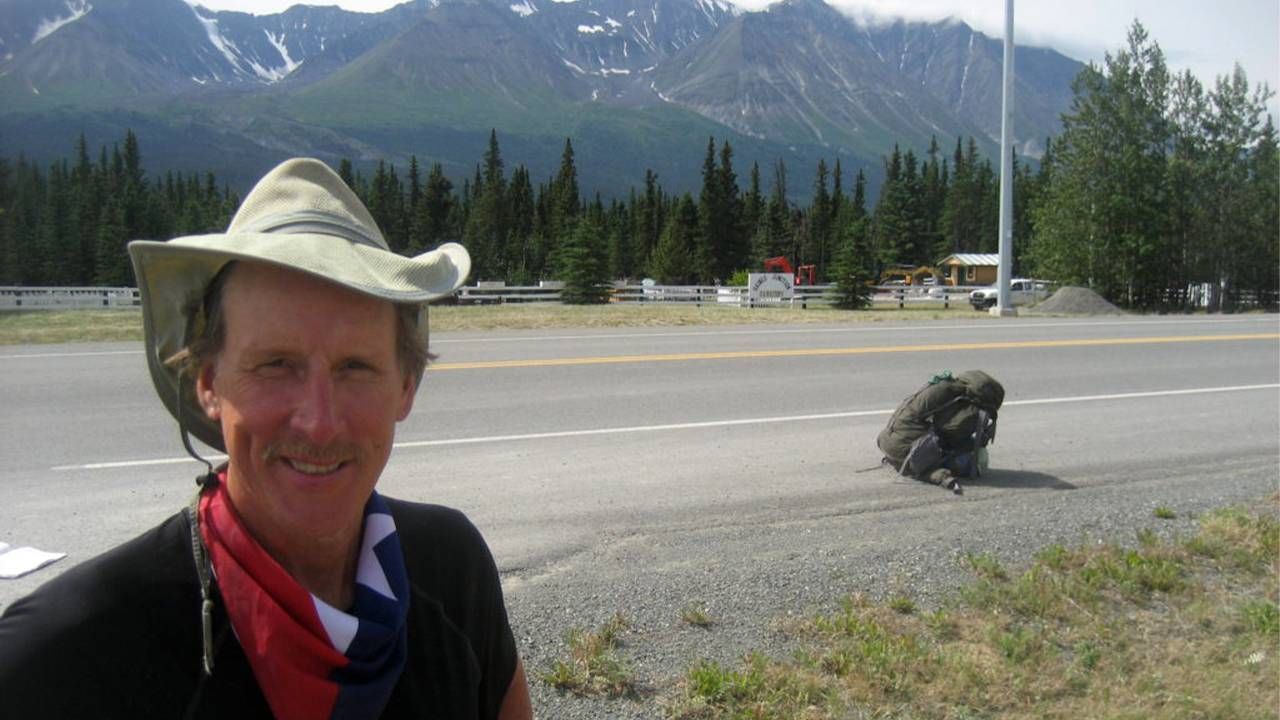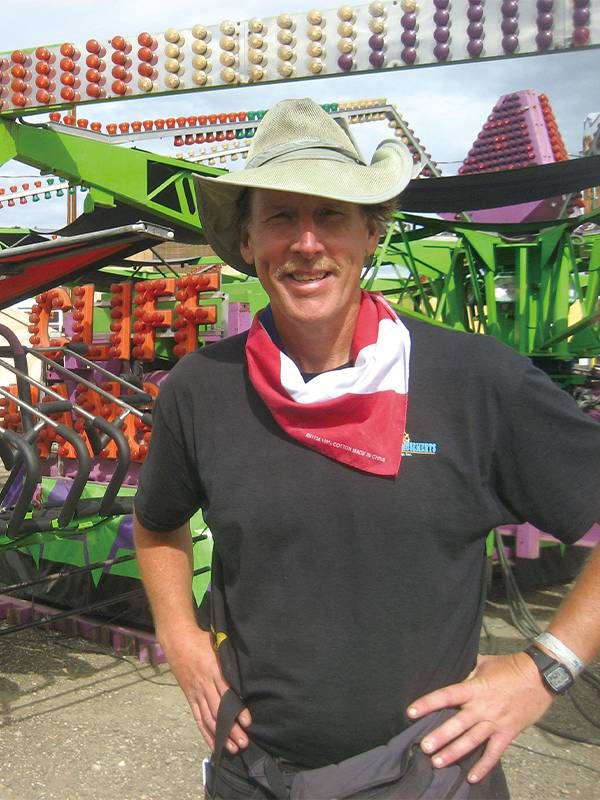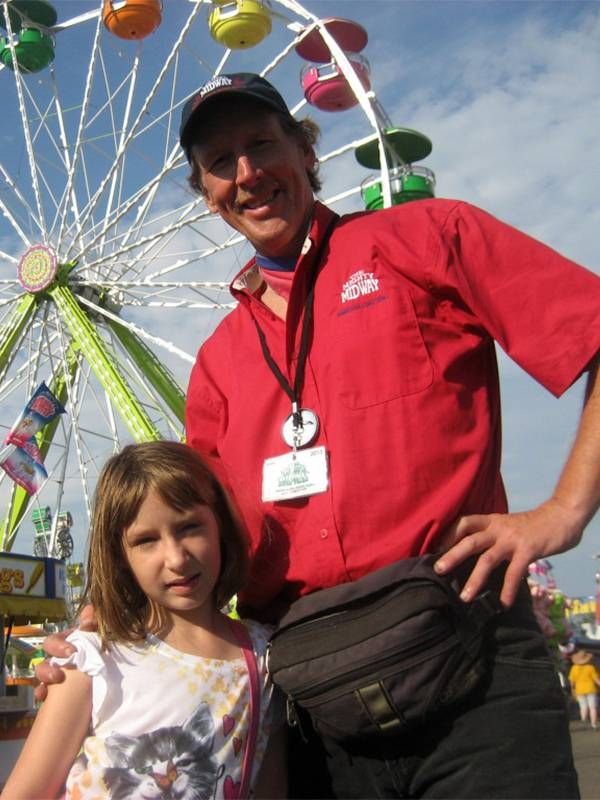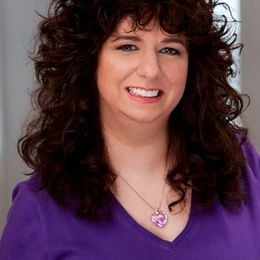A Journalist, Carny and Route 66 Cyclist Tells About Life on the Road
Author Michael Sean Comerford has explored America as a carnival worker, then as a cyclist on Route 66, all to fulfill his travel dreams
Michael Sean Comerford is a modern-day explorer. But instead of climbing the highest mountain or swimming the deepest river, he prefers to explore America — and did so through working at carnivals for a year and, more recently, bicycling across Route 66 filming people's COVID-19 stories.

As he chronicled in his bestselling book "American Oz: An Astonishing Year Inside Traveling Carnivals at State Fairs & Festivals," Comerford spent a year touring the country, working in carnivals. He went to 10 carnivals in 10 places — including working in Mexico and in Alaska.
Why would a man, then 54, go to work with people half his age in sometimes dangerous places? Simple: he was fulfilling a dream that started when he was just 22.
His First Carnival
In 1981, when he was a fresh-faced graduate of Marquette University in Milwaukee, Comerford says, "I jumped on my bicycle, and I rode west to Seattle. I eventually jumped on a freight train and came back that way."
"So I met people in the carnival.They had their own language. They had their own history."
While in Cody, Wyo. — founded as Comerford points out by Buffalo Bill Cody — he had connected with three guys from Massachusetts who were also riding coast to coast. They all got jobs for the July 4th weekend working at a carnival that was part of the Cody Stampede, an annual rodeo and celebration.
"So I met people in the carnival. They had their own language. They had their own history. They were characters," says Comerford. And he thought to himself that if he ever had the guts to become what he wanted to be — a writer — he would write about them. He knew, he says, "This is where all the stories are. There's a story happening here with every one of these human beings."
Fast forward a few decades. Comerford had become a writer and worked as a journalist all over the world. But he had yet to write a book. In 2013, "I revisited the idea of carnivals," he says. He thought that if he were going to do it right, he needed to live and work in the carnival community.

Wanting to highlight the disparity in income in the United States, Comerford decided to head to Silicon Valley, "where there's the most billionaires in America and the most homeless per capita," he says.
'I Became a Spy'
He got a job working at the Classic Amusement carnival there and was upfront with his boss, telling him he was going to be blogging about it. When the boss realized Comerford was a true journalist, he fired him. Comerford recalls him saying, "I can't control you [and what you write], so there's all downside for me."
But it wasn't all bad. The man sat Comerford down and talked with him about carnivals, how he needed to speak to Mexican workers — who were often the most prevalent in the field — and how every carnival owner would fire him if they found out he was a writer.
Although he didn't originally want to do it this way, Comerford followed the guy's advice.
"I didn't tell any owner," he says. He realized that he was going to enter the world of immersion that journalists had done decades — or even centuries — before. He was following in the footsteps of Nellie Bly, William Least Heat-Moon and most recently, Ted Conover.
Comerford recalls, "Against all my plans, I became a spy."
Behind the Scenes
In "American Oz," Comerford talks about many of the characters he met, how he hitchhiked to get to the next carnivals, how hard the work could be and the many times he was probably in much more danger than he ever expected.
"It's a hard job for a young man, and I wasn't young," Comerford recalls. He also found himself getting into a lot of confrontations where people wanted to fight him. He knew of drug deals going down, people beating each other up and a lot more. But he just kept writing.
"I blogged every day about it. I was writing until early in the morning and then getting up and working the whole day [in the carnival]," he says.
Eventually, when the adventure part was over, Comerford rewrote millions of words over the years to get his tome just right. He realized what the book was really about.
"This book is about the American caste system, about income inequality, but also about people living on a road and doing what we all do — looking for love and meaning in our lives. I was fleshing out the humanity behind the rides."
Pedaling During the Pandemic
Earlier this year, when many businesses were still shut down and people were reeling from the effects of COVID-19, Comerford, then 61, decided to take another adventure. He jumped on his bicycle and began riding from his hometown of Chicago, on Route 66, America's Main Street, with the plan to film five-minute interviews with people whenever he stopped to rest on his journey to California. His project, called The Story Cycle, began in a dream.
"You don't want to leave things undone that you always wanted to do."
"The idea came to me almost formed through the dream, which is most people live through COVID," says Comerford. "We have been having plagues and pandemics since human beings evolved. How did we survive this? What are the stories we're telling ourselves in order to survive?"
After that dream, Comerford, who is divorced, made a snap decision to go. Armed with a Nikon Z50 camera (which also takes high-definition video) and a laminated sign reading, "Tell Me A Story" fastened to the back of his bike, Comerford began his trip through eight states: Illinois, Missouri, Kansas, Oklahoma, Texas, New Mexico, Arizona and ending in California.
Even though he was leaving in winter, Comerford recalls thinking that he couldn't anticipate everything, but admits that his original route (which he changed) was going to lead him through areas with lots of snowstorms. That doesn't mean that Comerford, who turned 62 on his journey, was totally safe.
"I had five bicycle breakdowns. I started off in the snow [leaving Chicago] and was camping out in snow. In Missouri, it was freezing rain and tornadoes. Then in Oklahoma, there were 50-mile-an-hour winds. There was snow at the top of the Continental Divide, and then there was the Mojave Desert, which I hadn't properly hydrated for. I ended up lying down in the desert every half a mile [knowing] this is only making things worse because I'm dehydrating more, but I still couldn't ride anymore," he says.

Luckily, a good Samaritan in the form of caretaker Morris Swain of the Mojave Heritage and Cultural Association came along and gave Comerford water and sandwiches. Back at their home, Swain and his wife, Judy, entertained Comerford with songs and stories. Then Comerford returned the favor.
"I sang them three songs and told them four stories. They were a godsend," he says. On Comerford's YouTube Channel, The Story Cycle, they sing "(Get Your Kicks on) Route 66" to him.
Comerford compiled more than 100 interviews and learned a lot about Americans during the trip. While some are following scientists and government recommendations about COVID-19, others believed they didn't need to be vaccinated because they are protected by angels or even by having a positive attitude. One man who got the virus talks about taking cattle dewormer, which he believes cured him of COVID-19.
For fellow boomers or Gen Xers, Comerford has some advice: "Those early dreams that you had have real power and can really inspire you to do things that you didn't think you were capable of. I highly suggest you try it, because life is short. You don't want to leave things undone that you always wanted to do."
As for him, Comerford is working on a book about The Story Cycle. When reflecting on his journey, he realizes how much he got from it.
"I couldn't believe how great it was to go over the Great Divide in the snow. The mountains were so beautiful, and the people were so interesting. I was in awe of everyone I was meeting. It was fascinating," he says.
"When I left college, I was worried that I would find nothing to do in my life that would be interesting to me. These are interesting times," he notes. "These ["American Oz" and The Story Cycle] are interesting projects."


